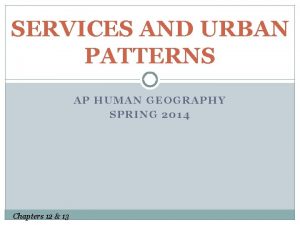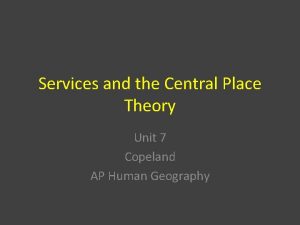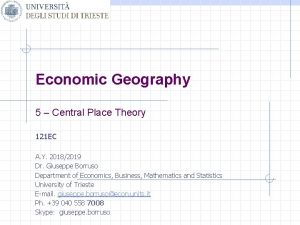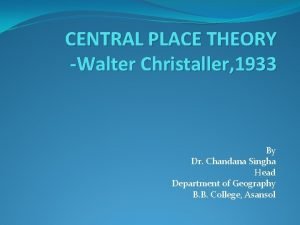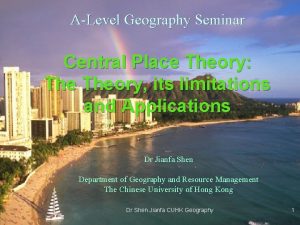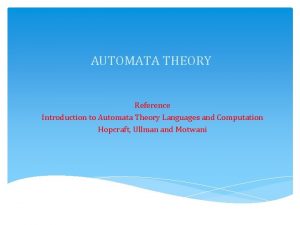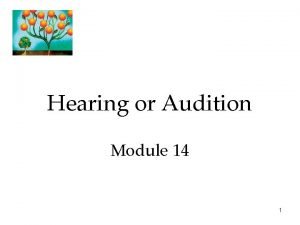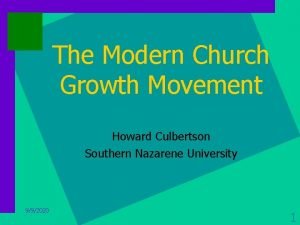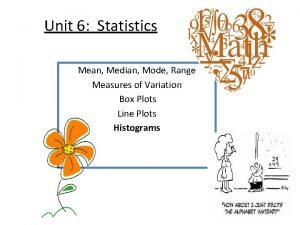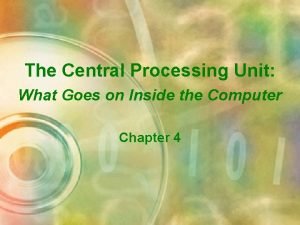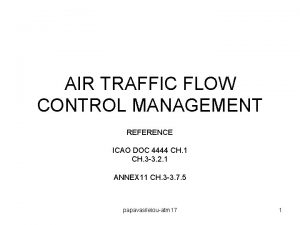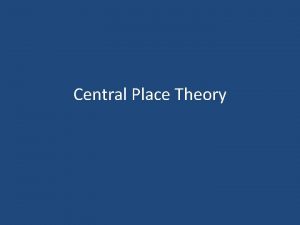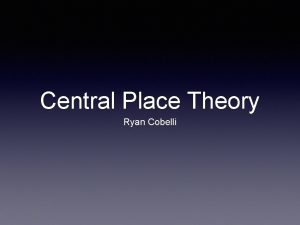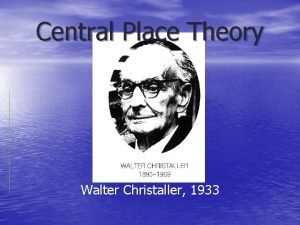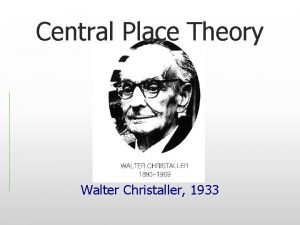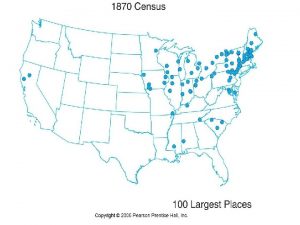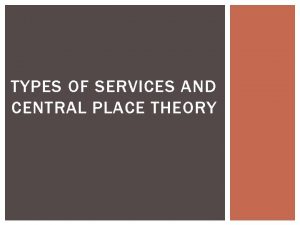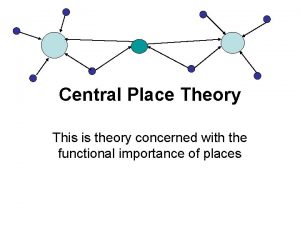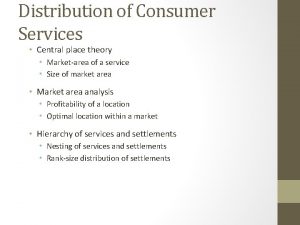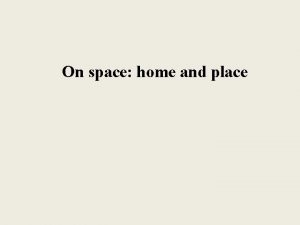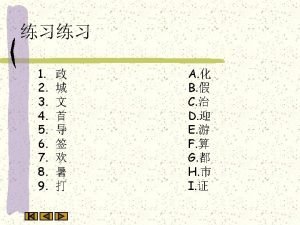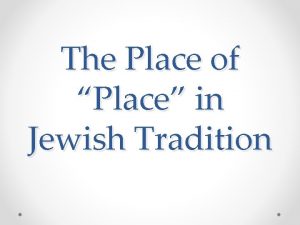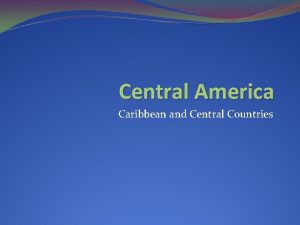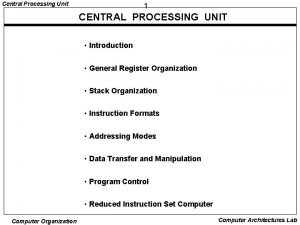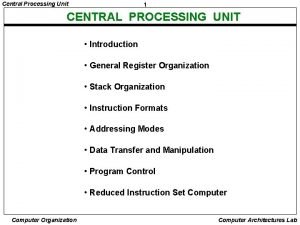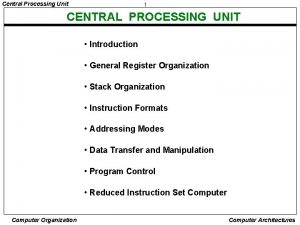Services and the Central Place Theory Unit 7
































































- Slides: 64

Services and the Central Place Theory Unit 7 Copeland AP Human Geography

What is a service? �Services: activity performed that fulfills a human want or need in exchange for money �Usually a link b/t services and settlements �Why are services clustered in settlements? �Optimal location may be a specific place �“location, location” �Services must also reflect distribution of people �Not the only factor b/c areas w/most population would have most svcs �People in MDCs can afford to purchase services so most are located there �Globalization of services-increasingly uniform �How is local diversity preserved?

Key Issue #1 WHAT ARE THE TYPES OF SERVICES?

Types of services • Consumer Services – Two types: • Retail service (about ¼ all consumer svcs jobs) • Personal service (about 1/5 all consumer svcs jobs) • Business Services – Purpose: to facilitate other businesses – Two types: • Producer services: help people conduct business • Transportation and similar services: diffuse and distribute services (½ transportation; other ½ information services) • Public Services – Provide security and protection for citizens and businesses

Types of Services cont. • These distinctions are not absolute-why? • Why do geographers find them useful? • How have the number of employees changed?

Origin of Services • Centered around settlements • Settlements at the core of services-Why?

Settlement Roots People have always been gregarious and cooperative. Communal dwellings within a village or hamlet have become the norm of human society. Settlements are often expressions of economic systems. Service occupations will generally lend to the growth of a settlement. The relative location of settlements could also lend to the growth of a settlement. Settlement Sizes • Hamlet • Village • Town • City • Metropolis

A Hierarchy of Educational Services City: University Town: High Village: School/Small College Elementary Hamlet: No Schools School

The Location of Urban Settlements and the Economic Base • • Urban centers are functionally connected to other cities and to rural areas. In order for the urban center to provide services for itself and its surrounding communities, the city must be efficiently located. What determines the location of a city? – Centrality – Physical characteristics – Resources • • By a process of “circular and cumulative causation”, a successful urban unit must change with the times in order to remain an attractive destination to its occupants. The Economic Base of a city includes those employees that are involved in the production of goods (basic sector) and those whose efforts are necessary to the future well-being of the urban unit itself (nonbasic sector). As settlements become larger, a greater proportion of the population is employed in nonbasic activities. The Multiplier Effect implies that as a city’s employment and population grow in the basic sector, the nonbasic sector will double that growth.

Functional Specialization of U. S. Cities • Most economically diversified cities… -NYC, LA, Chicago, Boston, Philadelphia, San Francisco, ATL, St. Louis • The functions of modern cities include: manufacturing, retailing, wholesaling, transportation, public administration, housing, education. • The fastest growing urban areas in America… Atlanta, Denver, Phoenix, Orlando, Dallas, San Antonio, Research Triangle of North Carolina

Key Issue #2 WHY ARE CONSUMER SERVICES DISTRIBUTED IN A REGULAR PATTERN?

Central Place Theory • Where are central places located? Why? • Central place theory explains how services are distributed and why there is a regular pattern of settlement • First proposed by Walter Christaller (1933) – Attempted to develop a model to predict how and where central places in cities would be spatially and functionally distributed








Shapes of Hinterlands • Are circles the best way to label central place? • No, reason why, is that circles must overlap or leave certain areas un-served. • Hence, Christaller chose perfectly fitted…






Christaller Critiqed • While many urban geographers doubted the relevance of the model, many economic geographers, especially in the United States, confirmed Christaller’s theory. It is particularly applicable in agricultural areas that have a uniform distribution of consumers and purchasing power.


Each central place function has a: • Threshold: the minimum number of people needed to support a central place function • With fewer customers a store cannot afford to stay in business. • Range: the maximum distance beyond which a person will not travel to purchase a good or service • Beyond a certain distance people cannot afford the travel costs.

Central Place Theory cont. – Set of assumptions: • Surface of the area would be flat and have no physical barriers • Soil fertility would be uniform • Population and purchasing power evenly distributed • Uniform transportation which would allow for direct travel from each settlement to the other • Goods and services could be sold in all directions out to a certain distance – Calculated the ideal model and then compared it to the real world • In cities, central places would be nested, so the largest central place would provide services to smaller places • Smaller places would provide services to even smaller places

Central Place Theory cont. • Christaller postulated: – cites would be regularly spaced w/central places where the same product was sold at relatively the same price and was a standard distance apart – Each city has a complementary region in which they have a monopoly on the sale of certain goods • Market Area of a Service – Market area/hinterland • How is a market area established? – Christaller chose hexagons-Why?

Central Place Theory cont. • Size of Market Area – To determine, need info about its range and threshold – Range of Service • How far you are willing to go for a service • Determined by observation of consumer behavior – Threshold of Service • Minimum number of people required to support the service (generate a profit) • How potential consumers are counted depends on the product

Central Place Theory cont. • Central Places Today – Geographer, Larry Ford says central place theory still has a place today. As people migrate… – Sunbelt phenomenon-movement of millions of Americans from North and Northeast to South and southwest and vice versa • Result of government economic and social policies • Some cities would respond by increasing services while others would not. • However, the Central Place Theory will always be relevant in a capitalist society. Why?

More small places than big places Big places farther apart than small places CENTRAL PLACE THEORY Ratio of big places to small places relatively constant

Market-Area Analysis • Used to determine if a market’s location will be profitable – Profitability of a Location • Calculate the range and threshold – Optimal Location Within a Market • Where in the market should the service be located to maximize profit? – Linear – Nonlinear Settlement

Hierarchy of Services and Settlements • Small settlements are limited to consumer services w/small thresholds b/c they do not have the people to support a lot of services • Larger settlements can support both – Yellow pages of a large city vs. that of a small city • Why travel when you can get it right here?

Hierarchy of Settlements and Services cont. • Nesting of Services and Settlements – Central place theory-MDCs would be hexagons unless interrupted by physical boundaries • Hamlets, villages, towns, cities • Rank-Size Distribution of Settlements – Ranking settlements based on largest to smallest population produces a regular pattern or hierarchy – Rank-size rule – When plotted, makes a fairly straight line – What happens if it is not a straight line when plotted? • Primate city rule; country’s largest city is called the primate city

Hierarchy of Settlements and Services cont. • Rank-Size Distribution of Settlements cont. – Followed by many LDCs – How does rank-size distribution have an impact on the quality of life for its inhabitants? • Periodic Markets – Collection of individual venders who come together to offer goods and services in a location on specified days – Mostly provided in LDCs or rural MDCs – Mainly mobile – Frequency varies by culture

Central Place Functions Categories of like services found in a central place • • • Grocery Stores Gas Stations Jewelry Stores Book Stores Hair Stylists Auto Dealerships • • • Houses of Worship Schools Doctors Dentists Museums Concert Halls

Higher-Order Functions Higher-Order Central Places • Provision of higher-order goods and services • Trade in goods and services that are more valuable and infrequently demanded • Because the goods and services are more valuable, people are willing to travel farther to shop. • Higher-order goods and services are available in higher-order central places.

Lower-Order Functions Lower-Order Central Places • Provision of lower-order goods and services • Trade in goods and services that are less valuable and frequently demanded. • Because the goods and services are less valuable, people are willing to travel only short distances to shop. • Lower-order goods and services are available in lower-order central places.

Would you travel farther to buy a new car or the week’s groceries? To buy a new car Would you travel farther to see your family physician or a heart specialist? To see a heart specialist Would you travel farther to go to elementary school or to go to high school? To go to high school

Stock Exchange Sports Stadium Regional Shopping Mall Major Department Store Income Tax Service Convenience Store Gas Station

Major League Baseball team locations 1950 and 2000

National Basketball Association team locations 1950 and 2000

National Football League team locations 1950 and 2010

National Hockey League team locations 1950 and 2011

Geography of Sports Teams Answer the following questions… *What helps to define a range of influence for a sports team in America? *In recent years, has America seen less and less fan loyalty to local teams? In your opinion, why?

Why don’t we ever see a perfect central place hierarchy? • Consumer behavior is determined by more than economic considerations. • The automobile has made long-distance travel popular (cheap and easy). • People make multiple-purpose shopping trips, often bypassing the smallest places. • The Internet has made it unnecessary to have customers nearby.

The Practical Value of Central Place Theory Become a city planner or developer

How could central place theory help you to choose a location for: • • A new hospital? A new high school? A new mall? A new café? A new Publix? Kroger? A new Starbucks? A new Chick-fil-a? A new baseball team?

Key Issue #3 WHY DO BUSINESSES LOCATE IN LARGE SETTLEMENTS? (RANK-SIZE RULE & HIERARCHY OF WORLD CITIES)

Ancient World Cities • Originally people clustered in agricultural villages – egalitarian society – main activity: agriculture • This changed as cities were formed – people generated personal wealth – began to trade over long distances – formation of stratified classes – engaged in a diversity of economic activities

Ancient World Cities cont. �Agricultural surplus and social stratification enabled the formation of cities-Why? 1. advances in technology � leadership class was formed to control the surplus and technology used to create it 2. king or priest/king centralized political power � in turn, demanded labor to create agricultural surplus which would help him/her retain political power �Leadership class controlled all of the society’s resources �since everyone did not participate in farming, could focus on other pursuits such as philosophy and religion �writing and recordkeeping arose from these activities Examples: Ancient Rome, Ancient Greece

Medieval World Cities • renewed urban life as feudalism spawned urban settlements • largest urban settlements served as power centers • usually fortified by walls • What were believed to be the 5 most populous cities in 900 A. D. ?

Modern World Cities • Business Services in World Cities • Consumer Services in World Cities • Public Services in World Cities

Hierarchy of Business Services • 4 levels of cities that play a role in business services • 1) World Cities – Why are they closely integrated into the global economic system? • London, New York, Tokyo – largest city of their main area – most important stock exchanges located there • Chicago, Los Angeles, Frankfurt, Paris – also included: Sao Paulo and Singapore – where many major banks or other corporations may have their headquarters • What cities make up the third tier?

Hierarchy of Business Services cont. 2) Command Control Centers �second level of cities �Transnational services, headquarters of multinational corporations, dominate worldwide commerce �What are some command/control center cities? 3) Specialized Producer-Service Centers �third level of cities �offer more narrow and highly specialized variety of services �What are some examples? 4) Dependent Centers �fourth-level cities �unskilled jobs; their economic health depends on the decisions of the other cities

Economic Base of Settlements cont. • Specialization of Cities in Different Services – Basic industries originally referred to manufacturing – Those specializing in public services are dispersed all over the country-why? • Distribution of Talent – Those with talent are not uniformly dispersed – Why do some cities have a larger number of talented individuals than others? – Richard Florida-what did his research about talent determine?

Key Issue #4 WHY DO SERVICES CLUSTER DOWNTOWN?

Central Business District (CBD) • Consumer and business services located in CBDs because of their accessibility • Retail Services in the CBD – Retail Services w/High Threshold • Accessible to a large number of people • Rents here were usually highest • Recently, most have disappeared for the suburbs – Retail Services w/ High Range • • Very specialized shop; customers patronize it infrequently Prefer central locations Have also moved to suburban shopping malls How can they still survive in CBDs?

Central Business District (CBD) cont. – Retail Services Serving Downtown Workers • • Cater to those who work in the downtown area Limited hours Many of these are expanding-Why? How have cities attempted to revitalize retailing in CBDs and older neighborhoods? – Producer Services • • Cluster in the center for accessibility Facilitates communication Helps to establish sense of trust Also allows businesses to employ people from all different neighborhoods – Can find employees they need in a CBD

Central Business District (CBD) cont. �High Land Costs in the CBD �Accessibility produces competition for land �As a result, extremely expensive � 2 characteristics emerge as a result: �Land is used more intensely at the center than elsewhere in the city �Some activities are excluded form the center because it is so expensive �Intensive Land Use �“underground city” �Use of more space above and below ground �Skyscrapers �Building up instead of out �Vertical geography-explain.

Central Business District (CBD) cont. • Activities Excluded from the CBD – Manufacturing • Requires too much space • Suitable land usually located in the suburbs – Lack of residents • Most individuals cannot afford the rent in CBDs • Where is this problem especially critical? • What are the push/pull factors for leaving CBDs?

 Coolness index ap human geography
Coolness index ap human geography Place theory
Place theory Central place theory
Central place theory Christaller central place theory
Christaller central place theory Christaller’s central place theory
Christaller’s central place theory Hinterland central place theory
Hinterland central place theory What is the central place theory
What is the central place theory Place place value and period
Place place value and period A central place and the surrounding territory linked to it
A central place and the surrounding territory linked to it Waves are repeating disturbances that transfer
Waves are repeating disturbances that transfer A wave is a disturbance that transfers energy
A wave is a disturbance that transfers energy Unit 6 review questions
Unit 6 review questions Hát kết hợp bộ gõ cơ thể
Hát kết hợp bộ gõ cơ thể Ng-html
Ng-html Bổ thể
Bổ thể Tỉ lệ cơ thể trẻ em
Tỉ lệ cơ thể trẻ em Voi kéo gỗ như thế nào
Voi kéo gỗ như thế nào Chụp tư thế worms-breton
Chụp tư thế worms-breton Chúa yêu trần thế alleluia
Chúa yêu trần thế alleluia Các môn thể thao bắt đầu bằng tiếng bóng
Các môn thể thao bắt đầu bằng tiếng bóng Thế nào là hệ số cao nhất
Thế nào là hệ số cao nhất Các châu lục và đại dương trên thế giới
Các châu lục và đại dương trên thế giới Công thức tiính động năng
Công thức tiính động năng Trời xanh đây là của chúng ta thể thơ
Trời xanh đây là của chúng ta thể thơ Mật thư anh em như thể tay chân
Mật thư anh em như thể tay chân 101012 bằng
101012 bằng độ dài liên kết
độ dài liên kết Các châu lục và đại dương trên thế giới
Các châu lục và đại dương trên thế giới Thơ thất ngôn tứ tuyệt đường luật
Thơ thất ngôn tứ tuyệt đường luật Quá trình desamine hóa có thể tạo ra
Quá trình desamine hóa có thể tạo ra Một số thể thơ truyền thống
Một số thể thơ truyền thống Cái miệng nó xinh thế chỉ nói điều hay thôi
Cái miệng nó xinh thế chỉ nói điều hay thôi Vẽ hình chiếu vuông góc của vật thể sau
Vẽ hình chiếu vuông góc của vật thể sau Thế nào là sự mỏi cơ
Thế nào là sự mỏi cơ đặc điểm cơ thể của người tối cổ
đặc điểm cơ thể của người tối cổ V. c c
V. c c Vẽ hình chiếu đứng bằng cạnh của vật thể
Vẽ hình chiếu đứng bằng cạnh của vật thể Phối cảnh
Phối cảnh Thẻ vin
Thẻ vin đại từ thay thế
đại từ thay thế điện thế nghỉ
điện thế nghỉ Tư thế ngồi viết
Tư thế ngồi viết Diễn thế sinh thái là
Diễn thế sinh thái là Dot
Dot So nguyen to
So nguyen to Tư thế ngồi viết
Tư thế ngồi viết Lời thề hippocrates
Lời thề hippocrates Thiếu nhi thế giới liên hoan
Thiếu nhi thế giới liên hoan ưu thế lai là gì
ưu thế lai là gì Hổ đẻ mỗi lứa mấy con
Hổ đẻ mỗi lứa mấy con Sự nuôi và dạy con của hổ
Sự nuôi và dạy con của hổ Hệ hô hấp
Hệ hô hấp Từ ngữ thể hiện lòng nhân hậu
Từ ngữ thể hiện lòng nhân hậu Thế nào là mạng điện lắp đặt kiểu nổi
Thế nào là mạng điện lắp đặt kiểu nổi Central concept of automata theory
Central concept of automata theory Central office services
Central office services Theories of hearing
Theories of hearing Teamwork
Teamwork Intserv vs diffserv
Intserv vs diffserv Wake county human services community services center
Wake county human services community services center Gavranuse
Gavranuse Mode in statistics
Mode in statistics Inside a central processing unit
Inside a central processing unit Central flow management unit
Central flow management unit Central coherence theory autism
Central coherence theory autism
